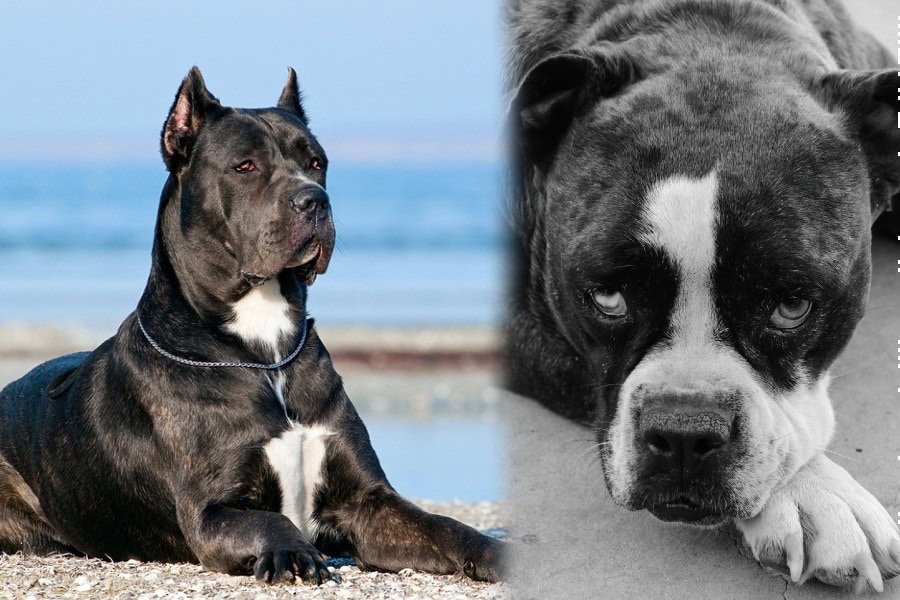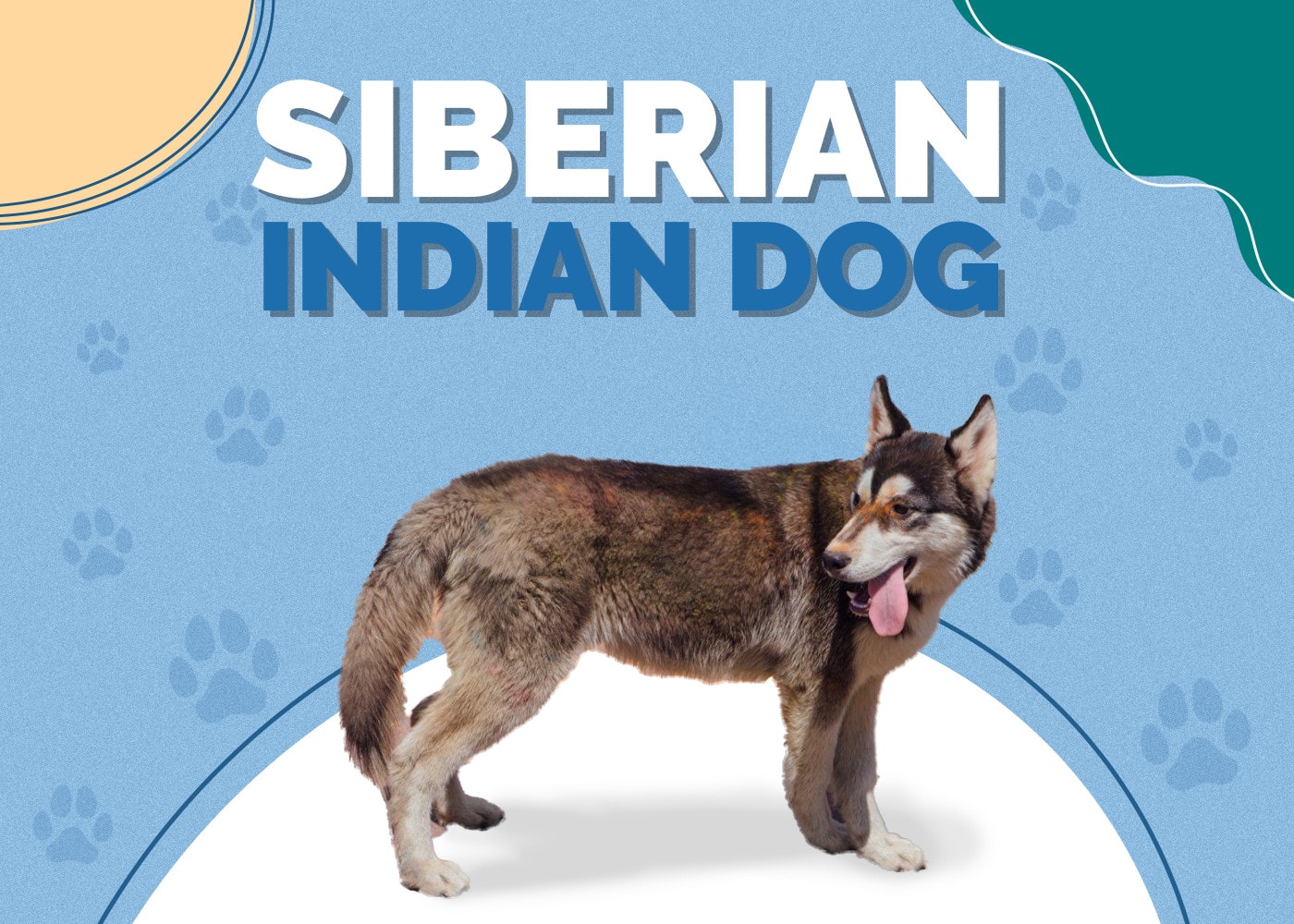Blue Blood Cane Corso (Alapaha Blue Blood Bulldog & Cane Corso Mix): Info, Pictures, Characteristics & Facts

Updated on

| Height: | 18–26 inches |
| Weight: | 50–120 pounds |
| Lifespan: | 10–12 years |
| Colors: | Blue, brown, red, white |
| Suitable for: | Families looking for a loyal and protective pet, experienced dog owners, those living in suburban or rural settings, homes without other pets |
| Temperament: | Loyal, protective, energetic, bossy, affectionate |
The Blue Blood Cane Corso is a cross between the Alapaha Blue Blood Bulldog and the Cane Corso. Both parent breeds have a similar size, and they both display similar temperaments, which means that, even though this is a hybrid breed, we still have a good idea of the probable looks and characteristics of the breed. Both parent breeds are also considered rare, and the crossbreed is even more difficult to find.
The Alapaha was bred in Georgia, US, to English Bulldog heritage. They were bred primarily for guarding and companionship and were regularly used for herding and herd protection. They were also considered effective hunters, making them versatile and useful plantation dogs.
The Cane Corso was bred in Italy and found a similar function as a protective herder and hunting dog. They descended from Roman war dogs and were first introduced to the USA in the late 1980s. They are mastiff-type dogs and have the appearance to match.
The Blue Blood Cane Corso dog is fiercely loyal and will protect their pack with their life, but if they are socialized and trained from a young age, they pose no danger to any family member and will get on especially well with children. They are considered one of the most child-friendly Pitbull-type dogs.
Blue Blood Cane Corso Puppies
Both the Alapaha and the Cane Corso are rare breeds. Their size and somewhat aggressive look mean that they are still most often used as guard dogs, rather than being adopted as a family pet. Their individual rarity makes the Blue Blood Cane Corso hybrid even rarer, which has an obvious impact on the price of puppies.
The rarity of the breed means that the Blue Blood Cane Corso can be difficult to find. In turn, this could mean traveling some distance to find a puppy. Always ensure that you get your puppy from a reputable and experienced breeder, especially for a breed of this size and stature.
Meet the breeder and have a look around their premises. A good breeder will keep their dogs in a warm and comfortable environment. The dogs themselves should be alert and happy. Ideally, you will be able to meet your puppy’s parents. Are they friendly with strangers? Are they alert and do they look healthy?
The breeder will have first-hand experience with the breed, as well as information specific to this puppy and his parents. Ask lots of questions. Take a look at the health history and screening certificates.
Getting a puppy is an exciting time for the whole family, but you shouldn’t rush in and take home the first dog you see. This hybrid breed is rare, but it is better to walk away and keep looking for a good breeder than to settle on a puppy that isn’t the right choice for you and your family.
Because the Blue Blood Cane Corso is so rare, it is unusual to find them in rescues and sanctuaries. However, their size means that there may be one or two examples. If you do adopt a dog from a rescue, make sure you meet them properly first. This breed can be headstrong and bossy, and they have been bred for hunting and herding, so if they show any signs of aggression you should walk away.
3 Little-Known Facts About the Blue Blood Cane Corso
1. Blue Blood Cane Corsos Are Big, But No Slouches
Mastiff and Mastiff crosses can come across as being lazy slouches. They carry a lot of weight and their giant stature means that agility is rare. However, the Blue Blood Cane Corso crosses a surprisingly spritely Mastiff, the Cane Corso, with the Blue Blood, which is an equally energetic bulldog breed.
The resulting hybrid breed is a dog that may appear lazy but is prized for their agility. They do require decent amounts of exercise and, although they are not necessarily prone to bouts of playfulness, they will be able to put in a good shift and can even do well in agility and related exercises.
2. They Are Not the Best Dogs for First-Time Owners
As well as being large and strong dogs, the Blue Blood Cane Corso breed can have a very strong prey drive. They are also very territorial and fiercely protective of their owners. They typically need a firm but fair hand to train them, and any owner needs to assert himself as pack leader from day one. The hybrid breed also requires early socialization and training.
These factors, combined with their energetic exercise requirements, mean that the breed is better suited to experienced owners rather than inexperienced ones.
3. Socialization and Training Are Vital
Socialization should be considered an important part of any puppy’s life. Even the most mild-mannered of breeds can be distrustful and potentially even a little bit aggressive if they are not socialized from an early age.
Socialization enables your dog to meet new people and other dogs, often in surroundings that they do not know, and it teaches them that new people are not a threat. Even though this hybrid breed is considered one of the best Bulldog breeds around children, early socialization is still key. Similarly, early training should be considered hugely important in the healthy and sociable development of a large dog like this.
Your Blue Blood Cane Corso will attempt to lead the pack unless you do, and this is where training is highly beneficial: it allows you to take charge, which is not only beneficial for you but also relieves a lot of pressure otherwise placed on the puppy.

Temperament & Intelligence of the Blue Blood Cane Corso 🧠
You will need to assert yourself as the leader of the pack when taking on a Blue Blood Cane Corso. This means that your dog will not have to shoulder the responsibility, and this is important in a breed as loyal and protective as the Blue Blood.
The hybrid is highly intelligent. If you establish yourself as the pack leader and train them consistently and firmly, with an even and controlled manner, they can be taught to be an extremely beneficial and loving member of the family. If you fail to meet these requirements, they will become bossy and might get agitated if you don’t follow their commands.
Both parent breeds have been bred for their companionship, and they are very loyal. They will form a strong bond with their owner, and this means that the hybrid breed can suffer separation anxiety. If you are out at work all day, and nobody will be home to spend some time with this breed, they can display destructive behavior, and the strength of their jaws means that your furniture and floor might suffer as a result.
Are These Dogs Good for Families? 🏡
The Blue Blood Cane Corso can have an aggressive look, but in most cases, they are a docile dog breed that adores their family and would never let them come to harm, let alone cause this harm themselves. Early socialization and consistent training are important, but if you offer both of these then you should expect a well-balanced dog that will get on well with all family members, especially the children.
Does This Breed Get Along With Other Pets? 🐶 😽
The Blue Blood Cane Corso is a dominant breed and has a strong prey drive. While it is possible to mix the breed with cats and other dogs if started from puppyhood, their hunting heritage means that you should be very careful indeed if trying to introduce an older dog to another pet. The breed will usually do better as a single pet, although there are exceptions to this rule, and many owners report success introducing the breed to other pets. If you have very small animals like guinea pigs or rabbits, special care needs to be taken, and you should avoid leaving your dog alone with these animals.
Things to Know When Owning a Blue Blood Cane Corso:
The Blue Blood Cane Corso has a unique appearance, surprisingly high energy levels, and is a fiercely loyal and loving companion dog. They can make a great pet but is better left to experienced owners rather than first-timers. Their size means that they are unlikely to do well in an apartment, and they will much prefer having the freedom to run around in their own yard to burn off energy.
In terms of appearance, the Alapaha is often described as an exaggerated bulldog. They have a very broad head and muscular shoulders. Their eyes are arguably their most outstanding feature, however, because they either have marble eyes or glass eyes. The Cane Corso is a large and muscular dog. They also have a broad skull and a very strong jaw. Your hybrid puppy may adopt the marble or glass eyes of their Alapaha forebear, but they may not. As both parent breeds have short, coarse hair, you can expect the hybrid breed to have similar.
Food & Diet Requirements 🦴
The Blue Blood Cane Corso is a big and energetic dog. As such, they will eat a lot. Although they are not usually prone to easily becoming overweight, you should stick to a recommended diet that will usually consist of between four and five cups of good quality dry kibble every day. Avoid leaving food out between mealtimes, if possible, and feed either two or three meals a day to sate their appetite and meet their nutritional requirements.
Exercise 🐕
The Cane Corso parent breed is a high-energy dog, and it is likely that your Blue Blood Cane Corso will need similarly high levels of physical and mental stimulation. As such, expect to have to take your dog on two long walks a day. This will help maintain their physical condition, and it will also prevent the disruptive behavior that dogs can exhibit when they get bored.
This breed especially enjoys being given jobs. They have been bred as herding and hunting dogs, after all. If you are unable to give them herding duties, look for ways to mimic the mental stimulation that this would offer. Teach them tricks, take them to agility and other physical exercise classes, and even take them running or cycling with you.
While it is technically possible for this breed to live in an apartment, their size, and their physicality usually prohibit this. They will prefer to live in a house with a decent yard because this will provide them with additional opportunities for exercise. If you do have a yard, ensure that it is properly walled or fenced. Lightweight fences will not be enough to contain a dog of this size, and their heightened prey drive means that they will be likely to chase after cats, small dogs, and other small animals, without proper containment.
Training 🦮
The Blue Blood Cane Corso is revered for his intelligence and, assuming that you start training from a young age and that you adopt a firm but fair training regimen, it is possible to train this breed in a variety of different areas. Firm training does not mean shouting and should never include physical reprimands. Hitting a dog is not only cruel, but it teaches them that it is okay to be physical.
Early socialization will ensure that your dog mixes well with other people and other animals, and this is especially critical with this breed. Although they are usually very mild-mannered with children and get along with all family members, they are very protective. If they haven’t been socialized and therefore do not know how to react to new people or new situations, you could pay the price.
Grooming ✂️
Both parent breeds have short, coarse hair, and they are both prone to shedding. Although their short hair can be difficult to spot, it will be lurking on the floor unless you groom them regularly. You might be able to get away with light brushing once or twice a week. This will help remove dead hair, ensuring comfort for your dog and minimizing the amount of hair in the house.
Check inside your dog’s ears and around their eyes every week, and clean out any gunk that might have appeared using a damp cloth. You should also brush his teeth at least twice a week, to ensure good dental health.
When it comes to nail trimming, your dog may naturally wear theirs down if they walk on concrete or another abrasive surface on a regular basis. However, if you start to hear them clicking on the floor, this is a good indication that it is time to get the nail clippers out. You should, at the very least, check them once or twice a month.
Health Conditions ❤️
The Blue Blood Cane Corso is considered a generally healthy dog, but there are certain illnesses and conditions that the parent breeds are prone to. There are also several complaints related to the size of the dog, and you should keep an eye out for all of these, to ensure that your dog is as healthy as possible.
- Eye disease
- Mange
- Bloat
- Hip dysplasia
Male vs Female
Females usually grow to a slightly smaller size than the male, and they are also considered easier to train. As such, females are better for inexperienced owners and for those who do not want the giant size of the male when their dog reaches full maturity. Males are not only more difficult to train, but they are more prone to dominant behavior so they can be harder to live with.
Final Thoughts:
The Blue Blood Cane Corso is descended from the Alapaha Blue Blood Bulldog and the Cane Corso. As such, it is a cross between a Bulldog and a Mastiff. They are considered friendly and attentive dogs, will usually get on with all family members, especially children, and are easy to train as long as you start from a young age and have a firm but friendly manner.
This hybrid breed does require a decent amount of exercise and will benefit from being given some kind of work or job to do, but you can expect a loyal and loving family member in return for your efforts. Their health is considered good, although their size means that they do not have the longest life expectancy. With good socialization and training from a young age, you should experience a pet that is great with all the family and with strangers.
See Also:
Featured Image Credit – Left: Sbolotova, Shutterstock Right: David Robert Perez, Shutterstock












